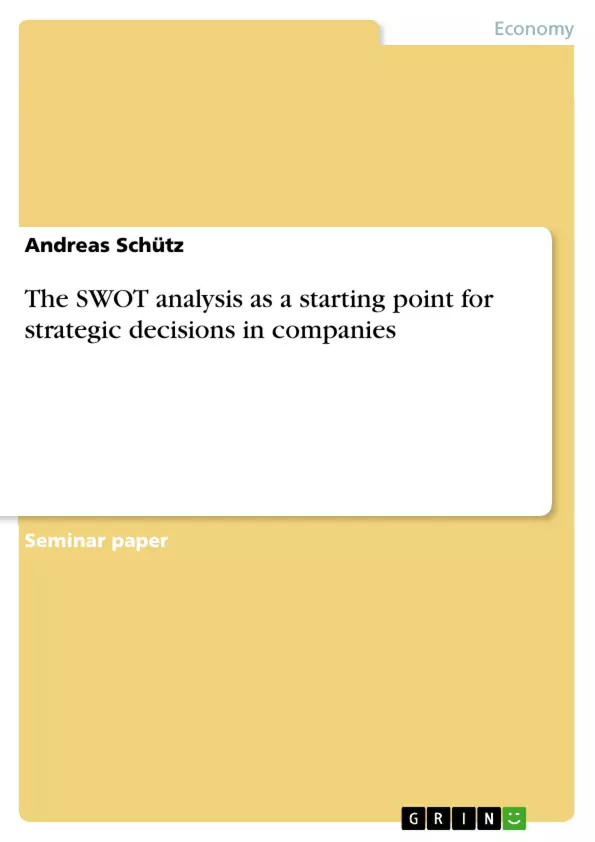The growing influence of customers on product design, increasing market dynamics, the negotiating power of suppliers, the decreasing half-life of product life cycles or political-legal and macroeconomic changes present companies with enormous challenges. In addition, the pressure of time, success and turnover tempt senior management to take ill-considered individual measures which may promise success in the short term, but are doomed to failure in the long term. Instead, before decisions are made, a well-founded analysis process is necessary that continuously weighs up opportunities and risks or strengths and weaknesses and embeds them in a corporate strategy that promises success.
The explosiveness and necessity of an instrument for the analysis of opportunities and risks or strengths and weaknesses can be well illustrated by current economic and political events, especially in the automotive industry, before the management tool of the SWOT analysis is explicitly discussed. [...]
At the beginning of this work a classification of the SWOT analysis in the process of the strategic management takes place, before then more near on the basic idea of this management tool is dealt with. The information from the environmental analysis in chapter 2.4 and enterprise analysis in chapter 2.5 flows into the illustration of a combined SWOT portfolio in chapter 2.6. After the presentation of the objectives and the consideration of advantages and disadvantages in chapter 2.8, a short summary of the results is given at the end of the thesis, as well as an assessment of the author with regard to the future relevance of the analysis tool as a starting point for strategic decisions in companies.
Inhaltsverzeichnis (Table of Contents)
- LIST OF ABBREVIATIONS
- 1 PROBLEM STATEMENT
- 2 SWOT ANALYSIS
- 2.1 Classification in the management control loop.
- 2.2 Basic idea.
- 2.3 Procedure ......
- 2.4 Environmental analysis: external opportunities and risks.
- 2.4.1 Analysis of the global business environment......
- 2.4.2 Industry analysis: Five-force model according to Porter.
- 2.5 Company analysis: internal strengths and weaknesses
- 2.5.1 Value chain analysis according to Porter...
- 2.5.2 Financial analysis
- 2.5.3 Benchmarking to identify potential competitive advantages ................ 13
- 2.6 Illustration of a combined SWOT portfolio.
- 2.7 Objectives of the SWOT analysis
- 2.8 Evaluation of the SWOT analysis
- 3 MANAGEMENT SUMMARY.
- 3.1 Summary
- 3.2 Outlook.
- BIBLIOGRAPHY
Zielsetzung und Themenschwerpunkte (Objectives and Key Themes)
This study aims to analyze the SWOT analysis as a starting point for strategic decisions in companies. It examines the tool's classification within the management control loop, its basic principles, and its practical application in various areas of company analysis. The study uses current economic events, particularly within the automotive industry, to demonstrate the relevance of the SWOT analysis in a dynamic and competitive environment.
- Strategic decision-making in the face of external and internal challenges
- Application of the SWOT analysis as a management tool for strategic analysis
- Importance of environmental and company analysis for effective decision-making
- Identification of strengths, weaknesses, opportunities, and threats for strategic planning
- Evaluation of the effectiveness of the SWOT analysis as a starting point for strategic decisions
Zusammenfassung der Kapitel (Chapter Summaries)
Chapter 1 introduces the problem statement, highlighting the increasing complexity of the business environment and the need for a comprehensive analysis process to support strategic decision-making. It uses examples from the automotive industry to demonstrate the importance of considering opportunities, risks, strengths, and weaknesses in developing a successful corporate strategy.
Chapter 2 delves into the SWOT analysis, providing a detailed explanation of its classification within the management control loop, its basic principles, and its procedural steps. It explores the environmental analysis, including the analysis of the global business environment and the five-force model according to Porter, as well as the company analysis, focusing on the value chain analysis according to Porter, financial analysis, and benchmarking.
Chapter 2 further discusses the illustration of a combined SWOT portfolio, outlining the objectives of the SWOT analysis and examining its evaluation.
Chapter 3 summarizes the findings of the study, highlighting the importance and relevance of the SWOT analysis in the contemporary business environment. It also presents the author's insights on the future application of the SWOT analysis as a starting point for strategic decisions in companies.
Schlüsselwörter (Keywords)
The core keywords and concepts examined in this study are strategic decision-making, SWOT analysis, management control loop, environmental analysis, company analysis, opportunities, risks, strengths, weaknesses, competitive advantage, strategic planning, and business environment.
- Quote paper
- Andreas Schütz (Author), 2011, The SWOT analysis as a starting point for strategic decisions in companies, Munich, GRIN Verlag, https://www.grin.com/document/1170976



